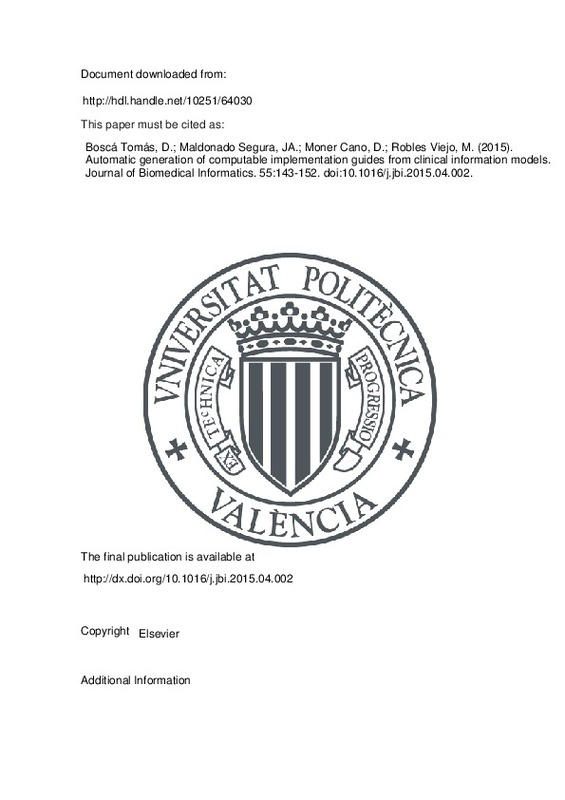JavaScript is disabled for your browser. Some features of this site may not work without it.
Buscar en RiuNet
Listar
Mi cuenta
Estadísticas
Ayuda RiuNet
Admin. UPV
Automatic generation of computable implementation guides from clinical information models
Mostrar el registro sencillo del ítem
Ficheros en el ítem
| dc.contributor.author | Boscá Tomás, Diego
|
es_ES |
| dc.contributor.author | Maldonado Segura, José Alberto
|
es_ES |
| dc.contributor.author | Moner Cano, David
|
es_ES |
| dc.contributor.author | Robles Viejo, Montserrat
|
es_ES |
| dc.date.accessioned | 2016-05-13T12:17:49Z | |
| dc.date.available | 2016-05-13T12:17:49Z | |
| dc.date.issued | 2015-06 | |
| dc.identifier.issn | 1532-0464 | |
| dc.identifier.uri | http://hdl.handle.net/10251/64030 | |
| dc.description.abstract | Clinical information models are increasingly used to describe the contents of Electronic Health Records. Implementation guides are a common specification mechanism used to define such models. They contain, among other reference materials, all the constraints and rules that clinical information must obey. However, these implementation guides typically are oriented to human-readability, and thus cannot be processed by computers. As a consequence, they must be reinterpreted and transformed manually into an executable language such as Schematron or Object Constraint Language (OCL). This task can be diffi- cult and error prone due to the big gap between both representations. The challenge is to develop a methodology for the specification of implementation guides in such a way that humans can read and understand easily and at the same time can be processed by computers. In this paper, we propose and describe a novel methodology that uses archetypes as basis for generation of implementation guides. We use archetypes to generate formal rules expressed in Natural Rule Language (NRL) and other reference materials usually included in implementation guides such as sample XML instances. We also generate Schematron rules from NRL rules to be used for the validation of data instances. We have implemented these methods in LinkEHR, an archetype editing platform, and exemplify our approach by generating NRL rules and implementation guides from EN ISO 13606, openEHR, and HL7 CDA archetypes. 2015 Elsevier Inc. All rights reserved. | es_ES |
| dc.language | Inglés | es_ES |
| dc.publisher | Elsevier | es_ES |
| dc.relation.ispartof | Journal of Biomedical Informatics | es_ES |
| dc.rights | Reserva de todos los derechos | es_ES |
| dc.subject | Archetype | es_ES |
| dc.subject | Clinical information model | es_ES |
| dc.subject | Data validation | es_ES |
| dc.subject | Implementation guide | es_ES |
| dc.subject | Natural Rule Language | es_ES |
| dc.subject.classification | FISICA APLICADA | es_ES |
| dc.title | Automatic generation of computable implementation guides from clinical information models | es_ES |
| dc.type | Artículo | es_ES |
| dc.identifier.doi | 10.1016/j.jbi.2015.04.002 | |
| dc.rights.accessRights | Abierto | es_ES |
| dc.contributor.affiliation | Universitat Politècnica de València. Instituto Universitario de Aplicaciones de las Tecnologías de la Información - Institut Universitari d'Aplicacions de les Tecnologies de la Informació | es_ES |
| dc.contributor.affiliation | Universitat Politècnica de València. Departamento de Física Aplicada - Departament de Física Aplicada | es_ES |
| dc.description.bibliographicCitation | Boscá Tomás, D.; Maldonado Segura, JA.; Moner Cano, D.; Robles Viejo, M. (2015). Automatic generation of computable implementation guides from clinical information models. Journal of Biomedical Informatics. 55:143-152. doi:10.1016/j.jbi.2015.04.002 | es_ES |
| dc.description.accrualMethod | S | es_ES |
| dc.relation.publisherversion | http://dx.doi.org/10.1016/j.jbi.2015.04.002 | es_ES |
| dc.description.upvformatpinicio | 143 | es_ES |
| dc.description.upvformatpfin | 152 | es_ES |
| dc.type.version | info:eu-repo/semantics/publishedVersion | es_ES |
| dc.description.volume | 55 | es_ES |
| dc.relation.senia | 291994 | es_ES |







![[Cerrado]](/themes/UPV/images/candado.png)

